Czy kiedykolwiek widziałeś przerażające ostrzeżenie „Niebezpieczne” w swojej przeglądarce i martwiłeś się, co to oznacza dla Twojej witryny? Jest to powszechna obawa, a terminy techniczne, takie jak SSL i HTTPS, mogą sprawić, że znalezienie rozwiązania wyda się przytłaczające.
Przeprowadziliśmy tysiące użytkowników przez ten dokładny proces, a dobrą wiadomością jest to, że zabezpieczenie Twojej witryny jest łatwiejsze, niż myślisz. To prosta zmiana, która buduje zaufanie odwiedzających, a nawet daje Ci niewielki wzrost w rankingach wyszukiwania.
W tym przewodniku przeprowadzimy Cię krok po kroku przez proces przenoszenia Twojej witryny WordPress z HTTP do HTTPS. Wyjaśnimy wszystko prostym językiem, dzięki czemu uzyskasz ikonę bezpiecznej kłódki obok nazwy swojej domeny.
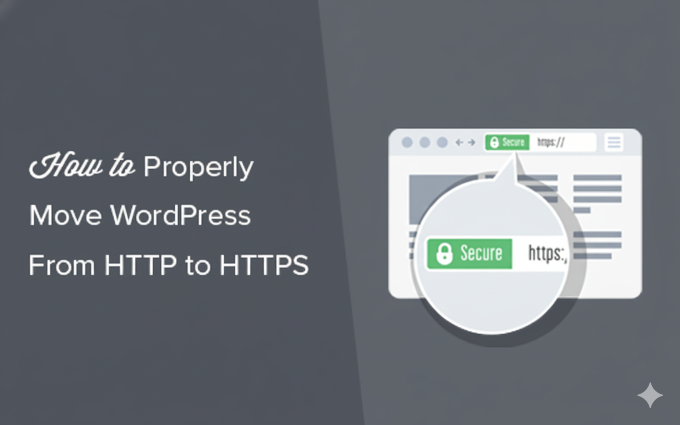
Szybkie podsumowanie: Jak przenieść WordPress do HTTPS w 4 krokach
- Uzyskaj certyfikat SSL.
- Zainstaluj i aktywuj wtyczkę SSL, taką jak Really Simple SSL.
- Zaktualizuj ustawienia swojej witryny, aby używać HTTPS.
- Skonfiguruj przekierowania i napraw wszelkie błędy mieszanej zawartości.
Oto szybki przegląd tematów, które omówimy w tym artykule:
- Czym jest HTTPS?
- Dlaczego potrzebujesz HTTPS i SSL?
- Wymagania dotyczące używania HTTPS/SSL na stronie WordPress
- Konfiguracja WordPress do używania SSL i HTTPS
- Metoda 1: Konfiguracja SSL/HTTPS w WordPress przy użyciu wtyczki
- Method 2: Set Up SSL/HTTPS in WordPress Manually
- Submit Your HTTPS Site to Google Search Console
- Często zadawane pytania dotyczące przenoszenia do HTTPS
- Dodatkowe zasoby dotyczące bezpieczeństwa WordPress
Czym jest HTTPS?
HTTPS (Hypertext Transfer Protocol Secure) to metoda szyfrowania, która zabezpiecza połączenie między przeglądarką użytkownika a serwerem Twojej witryny. To dodatkowe zabezpieczenie znacznie utrudnia hakerom przechwytywanie przesyłanych danych.
Aby utworzyć to bezpieczne połączenie, potrzebujesz certyfikatu SSL (Secure Sockets Layer). Chociaż „SSL” jest powszechnym terminem używanym przez ludzi, nowoczesna, bezpieczniejsza technologia, z której dziś korzystają witryny, nazywa się TLS (Transport Layer Security).
Każda witryna otrzymuje unikalny certyfikat SSL do identyfikacji. Jeśli serwer próbuje użyć HTTPS bez ważnego certyfikatu lub jeśli certyfikat nie pasuje, większość nowoczesnych przeglądarek ostrzeże użytkowników i zaleci im, aby nie kontynuowali.
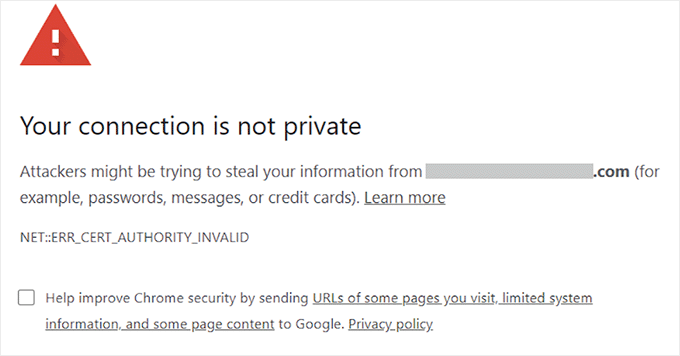
Dlaczego potrzebujesz HTTPS i SSL?
W 2018 roku Google ogłosiło inicjatywę mającą na celu zwiększenie bezpieczeństwa sieci, zachęcając właścicieli witryn do przejścia z HTTP na HTTPS. Aby wesprzeć ten ruch, ich przeglądarka Chrome zaczęła oznaczać wszystkie strony internetowe bez certyfikatu SSL jako „Niebezpieczne”.
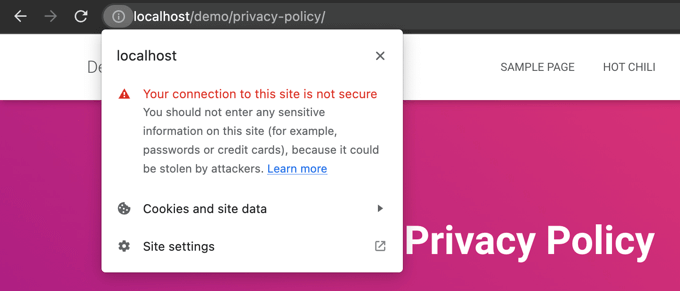
To ostrzeżenie „Niezabezpieczone” jest szczególnie widoczne, gdy ktoś próbuje wprowadzić informacje, na przykład wypełniając formularz kontaktowy. Widok tego ostrzeżenia może pozostawić negatywne wrażenie i nadszarpnąć zaufanie do Twojej firmy.
Dlatego wszystkie strony internetowe muszą przejść na HTTPS i zainstalować SSL. Oto główne korzyści:
- Poprawione bezpieczeństwo: Szyfruje dane wymieniane między Twoimi odwiedzającymi a serwerem, chroniąc poufne informacje, takie jak dane logowania i dane osobowe.
- Lepsze pozycjonowanie w wyszukiwarkach: Google przyznaje niewielką przewagę w rankingu bezpiecznym stronom HTTPS.
- Buduje zaufanie użytkowników: Ikona bezpiecznej kłódki w pasku adresu przeglądarki natychmiast sygnalizuje odwiedzającym, że Twoja witryna jest autentyczna i bezpieczna, co może poprawić współczynniki konwersji.
- Wymagane do płatności online: Jeśli chcesz akceptować płatności online na swojej stronie e-commerce, SSL jest wymagany przez dostawców płatności, takich jak Stripe, PayPal Pro i Authorize.net.
Zapewniamy, że wszystkie nasze własne strony korzystają z SSL, w tym WPBeginner i nasze firmy partnerskie.
Wymagania dotyczące używania HTTPS/SSL na stronie WordPress
Wymagania dotyczące korzystania z SSL w WordPress nie są zbyt wysokie. Wszystko, co musisz zrobić, to kupić certyfikat SSL, a być może już go masz za darmo.
Najlepsi dostawcy hostingu WordPress oferują darmowe certyfikaty SSL dla wszystkich swoich użytkowników:
Więcej szczegółów znajdziesz w naszym przewodniku, jak uzyskać darmowy certyfikat SSL dla Twojej strony WordPress.
Jeśli Twoja firma hostingowa nie oferuje darmowego certyfikatu SSL, będziesz musiał go kupić.
Polecamy Namecheap, ponieważ oferuje najlepszą ofertę SSL dla zwykłych certyfikatów SSL i certyfikatów wildcard.
Po zakupie certyfikatu SSL będziesz musiał poprosić swojego dostawcę hostingu o jego zainstalowanie.
Konfiguracja WordPress do używania SSL i HTTPS
Po włączeniu przez hosta certyfikatu SSL dla Twojej domeny, musisz skonfigurować WordPress, aby używał protokołów SSL i HTTPS na swojej stronie internetowej.
Pokażemy Ci dwie metody, jak to zrobić, a Ty możesz wybrać tę, która najlepiej odpowiada Twoim potrzebom.
Metoda 1: Konfiguracja SSL/HTTPS w WordPress przy użyciu wtyczki
Ta metoda jest łatwiejsza i zalecana dla początkujących.
Najpierw musisz zainstalować i aktywować wtyczkę Really Simple SSL. Więcej szczegółów znajdziesz w naszym przewodniku krok po kroku jak zainstalować wtyczkę WordPress.
Po aktywacji musisz odwiedzić stronę Bezpieczeństwo. Wtyczka automatycznie wykryje Twój certyfikat SSL i wyświetli opcję „Aktywuj SSL”.

Po aktywacji wtyczka zajmie się wszystkim, w tym błędami mieszanej zawartości.
Oto, co wtyczka robi w tle:
- Sprawdza ważność certyfikatu SSL
- Ustawia WordPress, aby używał https we wszystkich adresach URL
- Konfiguruje przekierowania z HTTP do HTTPS
- Wyszukuje adresy URL w Twojej treści, które nadal ładują się z niezabezpieczonych źródeł HTTP i próbuje je naprawić.
Uwaga: Wtyczka próbuje naprawić błędy mieszanej zawartości, używając techniki buforowania wyjściowego. Może to mieć negatywny wpływ na wydajność, ponieważ zastępuje zawartość na stronie podczas ładowania strony. Ten wpływ jest widoczny tylko przy pierwszym ładowaniu strony i powinien być minimalny, jeśli używasz wtyczki buforującej.
Chociaż wtyczka twierdzi, że można zachować SSL i bezpiecznie ją dezaktywować, nie jest to w 100% prawdą. Będziesz musiał pozostawić wtyczkę aktywną przez cały czas, ponieważ jej dezaktywacja spowoduje ponowne pojawienie się błędów mieszanej zawartości. Zobacz naszą recenzję Really Simple SSL, aby uzyskać więcej szczegółów.
Metoda 2: Ręczne skonfigurowanie SSL/HTTPS w WordPress
Ta metoda wymaga ręcznego rozwiązywania problemów i edycji plików WordPress. Jest to jednak trwałe, zoptymalizowane pod kątem wydajności rozwiązanie i jest to metoda, której używamy na WPBeginner.
Jeśli ta metoda okaże się trudna, powinieneś zatrudnić programistę WordPress lub zamiast tego skorzystać z pierwszej metody.
W ramach tej metody może być konieczna edycja plików motywu i kodu. Jeśli nie robiłeś tego wcześniej, zapoznaj się z naszym przewodnikiem na temat kopiowania i wklejania fragmentów kodu w WordPress.
Najpierw powinieneś odwiedzić stronę Ustawienia » Ogólne. Z tego miejsca zaktualizuj pola Adres WordPress i Adres witryny, zastępując http przez https.
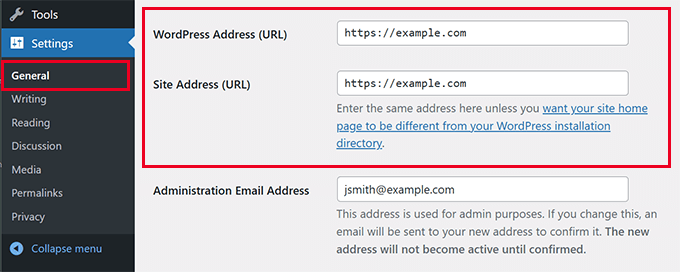
Następnie kliknij przycisk „Zapisz zmiany”, aby zapisać nowe ustawienia.
Po zapisaniu ustawień WordPress wyloguje Cię i poprosi o ponowne zalogowanie.
Następnie skonfiguruj przekierowania WordPress z HTTP do HTTPS, dodając następujący kod do pliku .htaccess. Ten kod jest przeznaczony dla serwerów Apache:
Jeśli korzystasz z serwera NGINX, dodaj następujący kod, aby przekierować z HTTP do HTTPS w pliku konfiguracyjnym:
Nie zapomnij zastąpić example.com swoją nazwą domeny.
Postępując zgodnie z tymi krokami, unikniesz błędu „WordPress HTTPS nie działa”, ponieważ WordPress będzie teraz ładował całą witrynę za pomocą HTTPS.
Aby wymusić SSL i HTTPS w obszarze administracyjnym WordPress lub na stronach logowania, musisz skonfigurować SSL w pliku wp-config.php.
Dodaj następujący kod powyżej linii „To wszystko, przestań edytować!” w pliku wp-config.php:
define('FORCE_SSL_ADMIN', true);
Ten stały parametr działa jako zabezpieczenie. Zapewnia, że Twoja strona logowania i panel administracyjny WordPress są zawsze szyfrowane, co dodaje dodatkową warstwę bezpieczeństwa dla administratora strony. Działa również w sieciach WordPress multisite.
Po wykonaniu tej czynności strona internetowa jest w pełni skonfigurowana do używania SSL / HTTPS, ale nadal możesz napotkać błędy mieszanej zawartości.
Naprawianie błędów mieszanej zawartości
Błędy mieszanej zawartości są spowodowane tym, że część zawartości (takich jak obrazy, skrypty lub arkusze stylów) jest nadal ładowana przez niezabezpieczony protokół HTTP zamiast HTTPS.
Pomyśl o tym jak o posiadaniu bezpiecznych, opancerzonych drzwi wejściowych (HTTPS), ale pozostawieniu otwartego okna (zasób HTTP). To jedno otwarte okno sprawia, że cały dom jest narażony.
Kiedy to się stanie, nie zobaczysz ikony bezpiecznej kłódki w pasku adresu Twojej witryny.

Możesz dowiedzieć się, która zawartość jest ładowana przez niezabezpieczony protokół, korzystając z narzędzia Inspect tool w swojej przeglądarce.
Błąd mieszanej zawartości zostanie wyświetlony jako ostrzeżenie w konsoli, ze szczegółami dla każdego elementu.
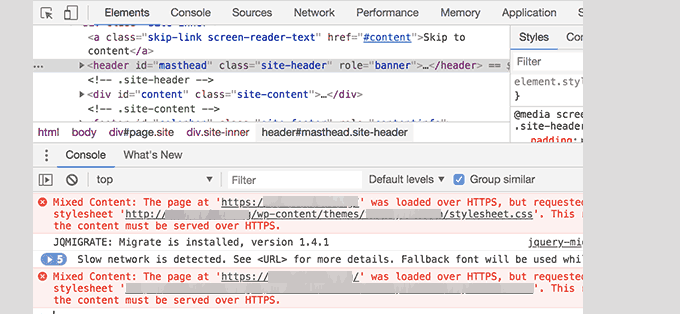
Zauważysz, że większość adresów URL to obrazy, ramki iframe i galerie obrazów, podczas gdy niektóre to skrypty i arkusze stylów ładowane przez wtyczki i motywy WordPress.
Naprawianie mieszanej zawartości w bazie danych WordPress
Większość nieprawidłowych adresów URL będzie dotyczyć obrazów, plików, osadzeń i innych danych przechowywanych w bazie danych WordPress. Naprawmy je najpierw.
Musisz znaleźć wszystkie wzmianki o starym adresie URL Twojej witryny w bazie danych, które zaczynają się od HTTP i zastąpić je nowym adresem URL Twojej witryny, który zaczyna się od HTTPS.
Możesz to łatwo zrobić, instalując i aktywując wtyczkę Search & Replace Everything.
Po aktywacji przejdź na stronę Narzędzia » WP Search & Replace. Musisz dodać adres URL swojej witryny z http w polu „Szukaj” i adres URL z https w polu „Zamień”.
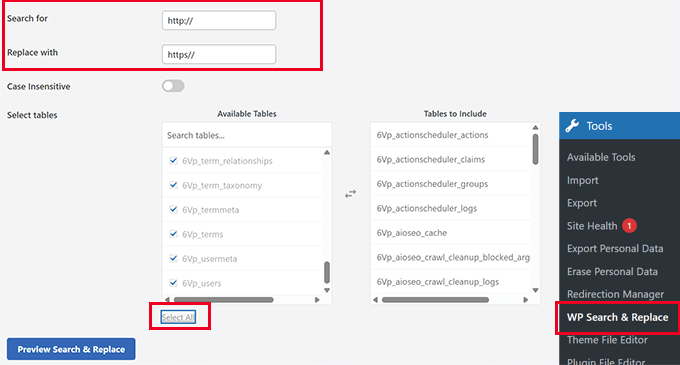
Następnie zaznacz wszystkie tabele bazy danych, aby przeprowadzić dokładne sprawdzenie i kliknij przycisk „Zamień wszystko”. Wtyczka zaktualizuje teraz wszystkie stare adresy URL w bazie danych.
Naprawianie błędów mieszanej zawartości spowodowanych przez motyw WordPress
Każdy przyzwoity motyw WordPress zgodny ze standardami kodowania WordPress nie spowoduje tego problemu. Jednak niektóre mogą nadal mieć zakodowane na stałe niezabezpieczone adresy URL.
Najpierw musisz użyć narzędzia Inspekcja przeglądarki, aby znaleźć zasoby i miejsca, z których są ładowane. Następnie musisz znaleźć je w swoim motywie WordPress i zamienić http na https.
Będzie to nieco trudne dla większości początkujących, ponieważ możesz nie być w stanie zobaczyć, które pliki motywu zawierają te adresy URL.
Naprawianie błędów mieszanej zawartości spowodowanych przez wtyczki
Niektóre zasoby z mieszaną zawartością będą ładowane przez wtyczki WordPress. Dowolna wtyczka WordPress zgodna ze standardami kodowania WordPress nie spowoduje błędów mieszanej zawartości.
Nie polecam edytowania plików wtyczek WordPress. Zamiast tego skontaktuj się z autorem wtyczki i poinformuj go. Jeśli nie odpowie lub nie będzie w stanie tego naprawić, wtedy znajdę odpowiednią alternatywę.
Uwaga: Jeśli z jakiegoś powodu nadal napotykasz błąd niezgodności zawartości, zalecamy tymczasowe użycie wtyczki Really Simple SSL, aby Twoi użytkownicy nie odczuli skutków podczas naprawiania problemu na stronie staging lub zatrudniania programisty.
Prześlij swoją stronę HTTPS do Google Search Console
Wyszukiwarki takie jak Google traktują https i http jako dwie różne strony internetowe. Aby uniknąć problemów z SEO, musisz poinformować Google, że Twoja strona internetowa została przeniesiona.
Aby to zrobić, wystarczy przejść do swojego konta Google Search Console i kliknąć przycisk „Dodaj właściwość”.
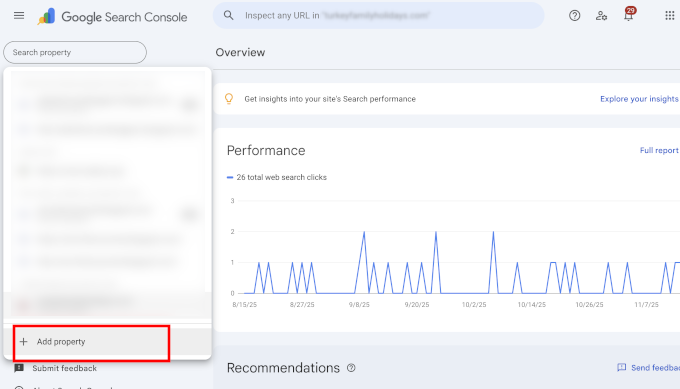
Spowoduje to wyświetlenie okna podręcznego, w którym musisz dodać nowy adres HTTPS swojej strony internetowej.
Google oferuje kilka sposobów weryfikacji Twojej witryny, ale zalecamy metodę prefiksu adresu URL, ponieważ jest ona bardziej elastyczna.
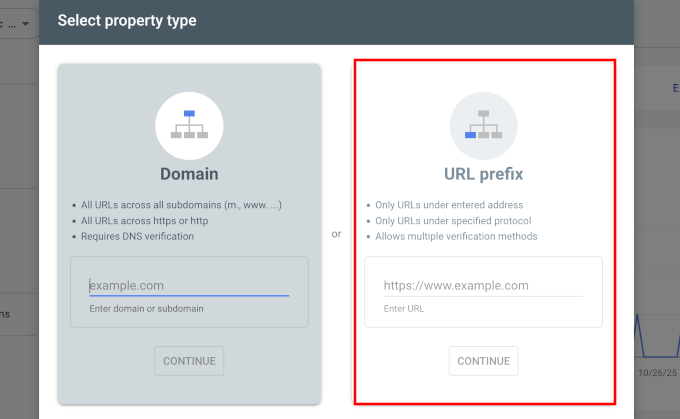
Następnie Google poprosi Cię o weryfikację własności Twojej witryny.
Istnieje kilka sposobów, aby to zrobić, ale zalecamy użycie metody tagu HTML. Otrzymasz fragment kodu HTML do dodania do swojej witryny WordPress.
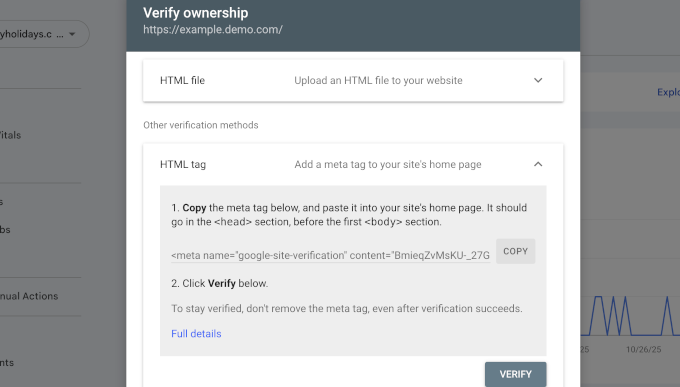
Dodaj kod weryfikacyjny Search Console za pomocą All in One SEO
Najpierw zainstaluj i aktywuj wtyczkę All in One SEO for WordPress. Więcej szczegółów znajdziesz w naszym poradniku jak zainstalować wtyczkę WordPress.
Wskazówka eksperta: W WPBeginner używamy All in One SEO na wszystkich naszych stronach internetowych. Funkcja weryfikacji narzędzi dla webmasterów oszczędza nam dużo czasu, ponieważ możemy po prostu wkleić kod, a AIOSEO automatycznie dodaje go we właściwe miejsce w nagłówku naszej witryny.
Po aktywacji przejdź do strony All in One SEO » Ustawienia ogólne i kliknij zakładkę Narzędzia dla webmasterów. Następnie kliknij Google Search Console.
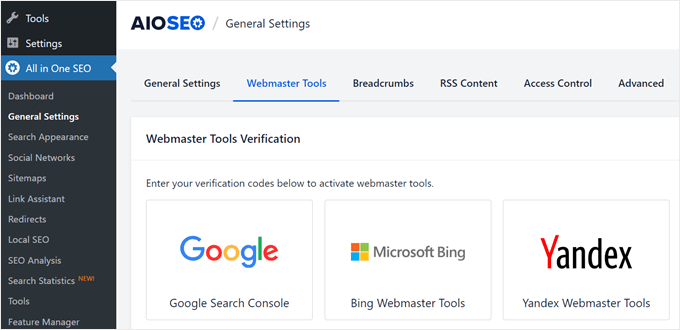
Tutaj musisz dodać kod weryfikacyjny, który wcześniej skopiowałeś ze strony Google Search Console. Nie zapomnij kliknąć przycisku „Zapisz zmiany”, aby zachować swoje ustawienia.
Następnie przełącz się z powrotem do karty Google Search Console i kliknij przycisk „Zweryfikuj”. Po zweryfikowaniu Twojej witryny Google zacznie wyświetlać raporty z Search Console.
Musisz również upewnić się, że zarówno wersje https, jak i http są dodane do Twojej Konsoli wyszukiwania.
Informuje to Google, że chcesz, aby wersja Twojej witryny https była traktowana jako wersja podstawowa. W połączeniu z przekierowaniami 301, które ustawiłeś wcześniej, Google przeniesie Twoje rankingi wyszukiwania do wersji https Twojej witryny.
Często zadawane pytania dotyczące przenoszenia do HTTPS
Ile kosztuje certyfikat SSL?
Certyfikat SSL może być darmowy. Większość najlepszych firm hostingowych WordPress oferuje darmowe certyfikaty SSL wszystkim swoim klientom za pośrednictwem Let's Encrypt. Jeśli Twój hosting nie oferuje darmowego, możesz kupić go od dostawcy takiego jak Namecheap za niewielką roczną opłatę.
Jaka jest różnica między SSL a HTTPS?
SSL (Secure Sockets Layer) to technologia, która szyfruje dane. HTTPS (Hypertext Transfer Protocol Secure) jest wynikiem użycia tej technologii SSL. Gdy witryna ma ważny certyfikat SSL, jej adres URL zaczyna się od https://, a w przeglądarce pojawia się ikona kłódki, wskazująca, że połączenie jest bezpieczne.
Co się stanie, jeśli nie będę używać HTTPS?
Jeśli nie będziesz używać HTTPS, nowoczesne przeglądarki, takie jak Google Chrome, wyświetlą odwiedzającym ostrzeżenie „Niebezpieczne”. Może to podważyć zaufanie, zaszkodzić reputacji Twojej marki i spowodować utratę potencjalnych klientów. Ponadto brak HTTPS może negatywnie wpłynąć na Twoje rankingi w wyszukiwarkach.
Dodatkowe zasoby dotyczące bezpieczeństwa WordPress
Poniżej znajduje się kilka dodatkowych zasobów, które mogą pomóc w rozwiązaniu typowych problemów z WordPress i dowiedzieć się więcej o bezpieczeństwie witryny:
- Jak naprawić typowe problemy z SSL w WordPress (przewodnik dla początkujących)
- Najczęstsze błędy WordPress i jak je naprawić
- Jak naprawić błąd bezpiecznego połączenia w WordPressie
Mamy nadzieję, że ten artykuł pomógł Ci dodać HTTPS i SSL w WordPress. Możesz również zapoznać się z naszym ostatecznym przewodnikiem po bezpieczeństwie WordPress z instrukcjami krok po kroku, jak utrzymać bezpieczeństwo Twojej witryny WordPress, lub z naszym przewodnikiem na temat jak odnowić certyfikat SSL.
Jeśli podobał Ci się ten artykuł, zasubskrybuj nasz kanał YouTube po samouczki wideo WordPress. Możesz nas również znaleźć na Twitterze i Facebooku.





Yasir
Czy ten plugin jest bezpieczny?
Wsparcie WPBeginner
Tak, wtyczka powinna być obecnie zabezpieczona.
Admin
ammar
Cześć, jeśli używam pierwszej metody, czy muszę również wykonać krok „Prześlij moją witrynę HTTPS do Google Search Console” po tym?
TQ
Wsparcie WPBeginner
Tak, nadal powinieneś wykonać ten krok
Admin
Swen
Zainstalowałem wtyczkę Really Simple SSL, która mówi, że należy ręcznie zastąpić każde http:// we wszystkich plikach .css i .js przez //. To nie brzmi dla mnie naprawdę prosto. Jako początkujący stworzyłem prostą stronę internetową z kilkoma zdjęciami. Czy to powszechne, że w tych plikach znajdują się instrukcje http://?
Wsparcie WPBeginner
Zazwyczaj takie linki nie są powszechne, więc nie powinno to być powodem do niepokoju.
Admin
Lucas
Cześć,
Podczas dodawania kodu do .htaccess pojawia się błąd „za dużo przekierowań”. Próbowałem dodać go do istniejącego kodu powyżej, poniżej, a także usunąć istniejący kod i użyć tylko nowego. Wszystkie trzy opcje powodują zbyt wiele przekierowań.
Czy jest coś, co powinienem tam zmienić? Z góry dziękuję za pomoc!
Wsparcie WPBeginner
Chciałbyś wypróbować niektóre z sugestii zawartych w naszym artykule tutaj:
https://www.wpbeginner.com/wp-tutorials/how-to-fix-error-too-many-redirects-issue-in-wordpress/
aby rozwiązać problem zbyt wielu przekierowań, a jeśli te zalecenia nie zadziałają, powinieneś skontaktować się z dostawcą hostingu, aby upewnić się, że nie mają oni systemu, który wymaga modyfikacji, aby wskazywał na wersję https Twojej witryny.
Admin
Sotir Sotirov
Próbowałem użyć wtyczki, ale kiedy to robię, strona internetowa staje się niedostępna. Próbowałem podejścia ręcznego, ale gdy tylko zmieniłem adresy w ustawieniach WP, strona ponownie staje się niedostępna.
Wsparcie WPBeginner
You would want to reach out to your hosting provider to ensure that your SSL certificate is connected to your domain correctly and they should be able to help
Admin
Mike Ashworth
Zamierzam dokonać zmiany na SSL i będę postępować zgodnie ze wskazówkami z artykułu, początkowo używając wtyczki Really Simple SSL. Zanim zacznę, mam szybkie pytanie.
Jeśli użyję wtyczki Really Simple SSL, która wszystkim się zajmuje, czy mogę pozostawić ogólne ustawienia w WordPressie dla adresu WordPress i adresu strony jako http zamiast zmieniać na https, ponieważ wtyczka będzie się tym zajmować?
Wsparcie WPBeginner
Correct
Admin
Mike Ashworth
Dziękuję za potwierdzenie. Mam jeszcze jedno pytanie.
po aktywowaniu certyfikatu Let's Encrypt SSL na SiteGround dla strony internetowej, pytam, czy chcę włączyć poniższe opcje, czy je wyłączyć.
Wymuszanie HTTPS – Wymusza, aby Twoja witryna działała w całości przez zaszyfrowane połączenie HTTPS. Przekierowanie jest wykonywane na poziomie serwera i działa dla każdej witryny.
Czy mam to pominąć, ponieważ wtyczka Really Simple SSL również się tym zajmie?
Wsparcie WPBeginner
Tak, możesz to pominąć, powinieneś tego używać tylko w przypadku problemów z wtyczką lub gdy Google nie znajdzie linków http.
Mike Ashworth
Dziękuję za Twoją radę. WP Beginner to niesamowita strona internetowa. Tak trzymajcie!
stephan
Bardzo dziękuję. Szukałem błędów przez ponad 12 godzin i udało mi się je naprawić dzięki lepszym wtyczkom do zastępowania. Wielkie dzięki, drogi.
Wsparcie WPBeginner
Glad our recommendation could help you
Admin
Arlina
Czy dodanie wtyczki SSL spowalnia działanie mojego bloga?
Wsparcie WPBeginner
Nie powinna spowolnić Twojej witryny
Admin
Peter Wilson
Czy ktoś może mi powiedzieć, czy mam zastąpić zawartość pliku my.htaccess. sugerowanym kodem, czy mam go umieścić na początku/końcu istniejącego wpisu.
Wsparcie WPBeginner
Dodałbyś to na końcu bieżącego kodu w swoim pliku htaccess.
Admin
Peter Wilson
Dzięki za szybką odpowiedź. Czy więc będzie to po istniejącym i przed # END WordPress, czy też po kropce.
Wsparcie WPBeginner
That should not matter, it may be a good idea to do it after should you need to remove the code in the future
Shivanandana
Naprawdę świetny poradnik. Dziękuję bardzo! Jeszcze raz dziękuję za ten szczegółowy post!
Wsparcie WPBeginner
Glad you like our content
Admin
Håkan
Świetna treść, bardzo mi pomogła!
Wsparcie WPBeginner
Thank you, glad our content was helpful
Admin
Harsha
Bardzo pomocny przewodnik, dziękuję bardzo!
Wsparcie WPBeginner
You’re welcome, glad our article was helpful
Admin
Jan-Peter Molenaar
Thanks a lot!! Valuable content
Wsparcie WPBeginner
You’re welcome, glad our content is helpful
Admin
Greg
Ten artykuł był bardzo pomocny. Dziękuję bardzo! Ułatwił sprawę.
Wsparcie WPBeginner
You’re welcome, glad our article was helpful
Admin
Nel
Najbardziej pomocny przewodnik w historii. Dziękuję za to.
Wsparcie WPBeginner
You’re welcome
Admin
Jessica Quadra
To było bardzo pomocne i każdy krok działał idealnie. Dziękuję!!
Wsparcie WPBeginner
You’re welcome, glad our guide could help
Admin
Hassen Loukil
Cześć!
Dzięki za artykuł!
A co z Google Analytics? To to samo co Google Search Console czy nie?
Wsparcie WPBeginner
W przypadku Google Analytics powinieneś móc zaktualizować do https w ustawieniach swojej nieruchomości
Admin
Arif Ahmed
Kiedy włączam opcję „WordPress 301 redirection to SSL” z wtyczki „Really Simple SSL Plugin”, działa ona poprawnie, ale usuwa parametry zapytania. Na przykład, gdy otrzymuję użytkowników z kampanii Adwords, usuwa parametry gclid.
Proszę o wskazówki
Wsparcie WPBeginner
Chciałbyś skontaktować się z pomocą techniczną Really Simple SSL, aby sprawdzić, czy istnieje opcja dla ciągów zapytania.
Admin
Oswald Porter
Dzięki za pomocny artykuł.
Wygląda na to, że ręczna konfiguracja SSL/HTTPS działa dla głównej strony.
Jednak błąd mieszanej zawartości (obrazy) nadal się pojawia po użyciu wtyczki Better Search Replace.
W Bibliotece Mediów obrazy wyświetlają się z „https”, ale nie na każdej stronie posta.
Faktycznie, na wszystkich postach, gdy kliknę prawym przyciskiem myszy na obraz posta i wybiorę „Kopiuj adres obrazu”, pokazuje się:
http://
Pomysły? Z góry dziękuję.
Wsparcie WPBeginner
Zacznij od wyczyszczenia pamięci podręcznej na swojej stronie, a jeśli to nie pomoże, możesz spróbować wtyczki Velvet Blues z naszego artykułu: https://www.wpbeginner.com/plugins/how-to-update-urls-when-moving-your-wordpress-site/
Admin
Kathy
Cześć,
Użyłem tego tutoriala na wielu stronach i działa jak marzenie. Dzięki za to.
Czy wiesz, czy mogę go również użyć do aktualizacji moich witryn multisite? Czy potrzebne są dodatkowe kroki?
Wsparcie WPBeginner
W zależności od sposobu konfiguracji multisite, zazwyczaj wymaga to więcej kroków. Jeśli skontaktujesz się ze swoim dostawcą hostingu, zazwyczaj mogą pomóc.
Admin
Ralph
Dzięki, bardzo fajny tutorial.
Wsparcie WPBeginner
Thanks, glad you liked our guide
Admin
Oz
Fantastyczne i proste!
Jakie kroki musimy podjąć, aby upewnić się, że nasze liczniki udostępnień w mediach społecznościowych (np. Facebook, Twitter) są nadal dostępne?
Wsparcie WPBeginner
Możesz spróbować przekierować artykuły http do https za pomocą 301, ale chyba że usłyszę inaczej, strony mediów społecznościowych traktują te dwa linki jako różne, więc prawdopodobnie stracisz udostępnienia, chyba że dodali metodę aktualizacji liczników udostępnień.
Admin
Ahsan
Użyłem Cloudflare dla darmowego SSL, ale mój ruch spadł o 25%. Czy to z powodu Cloudflare?
Wsparcie WPBeginner
Istnieje wiele możliwych przyczyn zmian w ruchu, więc trudno powiedzieć, czy to był jedyny powód, czy też były inne powody spadku ruchu.
Admin
Shawn
Dziękuję za tak świetny materiał.
Wygląda na to, że używanie wtyczki Really Simple SSL jest znacznie łatwiejsze niż samodzielna zmiana kodów i skryptów.
Moje pytanie – co jeśli wtyczka nie zostanie zaktualizowana w przyszłości? Czy to spowoduje problem z naszymi adresami URL?
I po zainstalowaniu SSL od mojego hostingu, wszystko co muszę zrobić to aktywować wtyczkę Really Simple SSL i wszystko zostanie przekierowane na https?
Shawn
Wsparcie WPBeginner
Zależałoby to od tego, jakie zmiany w rdzeniu kodu WordPress i jak długo nie był aktualizowany, odnośnie możliwych problemów. Wtyczka powinna automatycznie zaktualizować Twoje treści, aby mogły korzystać z HTTPS bez konieczności modyfikowania czegokolwiek po Twojej stronie, jeśli tego chciałeś.
Admin
Nathaniel
Chciałem tylko podziękować. Nie cieszyłem się na robienie tego, ale twój przewodnik sprawił, że było to łatwe i szybkie. Dzięki!!!
Wsparcie WPBeginner
Glad our guide could help
Admin
Sheri Ellis
Popełniłem błąd, postępując zgodnie z instrukcjami z Twojego podręcznika, zanim zainstalowaliśmy nasz certyfikat SSL. Zmieniłem tylko ogólne ustawienia adresu URL na https. I teraz strona jest zepsuta. Edytowałem każdy plik PHP, aby dodać:
define( ‘WP_HOME’, ‘http://mysite.com’ );
define( ‘WP_SITEURL’, ‘http://mysite.com’ );
i jest ignorowane. Więc teraz moja strona jest zepsuta. Informacyjnie używam WordPressa 5.1.1, który wydaje się mieć znaczące zmiany. Pomocy!
Wsparcie WPBeginner
Powinieneś móc edytować adres URL z powrotem za pomocą phpMyAdmin, podobnie jak w naszym artykule tutaj: https://www.wpbeginner.com/beginners-guide/how-to-reset-a-wordpress-password-from-phpmyadmin/
i edytować tabelę opcji, a nie tabelę użytkowników.
Admin
Sheri Ellis
Dziękuję za odpowiedź, ale to nie zadziałało. Uruchomiłem wiersz poleceń MySQL, aby zaktualizować tabelę wp_options i ustawiłem option_value na http, gdzie option_name to ('home','siteurl'). Wstawiłem również polecenia define HOME i SITEURL do wielu plików PHP, w tym wp-config.php, a także dodałem define( ‘RELOCATE’, true );
Nadal zepsute. Doceniam wszelkie dodatkowe sugestie!
Wsparcie WPBeginner
You may want to ensure if you have a caching plugin that you disable it, as you are unable to log into the site you could use: https://www.wpbeginner.com/plugins/how-to-deactivate-all-plugins-when-not-able-to-access-wp-admin/
otherwise, if you reach out to your hosting provider they should be able to assist
Sheri Ellis
Próbowałem tego również, bez powodzenia. Musiałem zniszczyć całą stronę i zainstalować ponownie WP. Ale doceniam wysiłek!
John J Cooke
Dzięki temu zmiana była błyskawiczna. Miałem certyfikat SSL, ale nie wiedziałem, jak go przekonwertować. Naprawdę doceniam proste instrukcje.
Wsparcie WPBeginner
Glad we could make the process easier for you
Admin
Mandee
O mój Boże, DZIĘKUJĘ! Skontaktowałem się z moją firmą hostingową, a także z programistą. Obaj sprawili, że wydawało się to niemożliwe do zrobienia samodzielnie. Zajęło to dosłownie 30 sekund dzięki Tobie. Nie mogę Ci wystarczająco podziękować! Szkoda, że nie znalazłem tego artykułu wcześniej – zaoszczędziłbym sobie wiele kłopotów!!
Wsparcie WPBeginner
Glad our article could help
Admin
Jerry
Cześć,
Próbowałem dwa razy Twojego przewodnika krok po kroku i wszystko działało świetnie. Teraz, gdy mam SSL, próbuję migrować, ale na ostatnim kroku jest problem, więc nie można go sfinalizować. Czy to problem, że miałem Let's Encrypt na starym serwerze, a teraz nowy ma inny, co mogło spowodować problem. Czy poleciłbyś usunięcie SSL na starym hostingu, a następnie użycie dublicatora do rozpoczęcia procesu artykułów?
Wsparcie WPBeginner
To, kto ma Twój SSL, nie powinno mieć wpływu na to, że nie działa, możesz spróbować sprawdzić, czy to pomoże, ale zazwyczaj jest to spowodowane inną przyczyną.
Admin
BILAL ALI AHMAD
Cześć,
Zastosowałem wszystkie kroki i wersja https działa poprawnie na mojej stronie, ale wersja bez https jest nadal dostępna, gdy wpiszę http: mysite.com
jak rozwiązać ten problem?
Również, kiedy klikam na link do wyszukiwania Google dla mojej strony internetowej, użytkownik trafia również na wersję bez https, a po tym, jeśli ponownie wejdę na stronę, pojawia się z https
proszę powiedz mi, jak rozwiązać ten problem?
Wsparcie WPBeginner
Jeśli już przesłałeś swoją witrynę do Google Search Console, Google mógł buforować wersję http w swojej wyszukiwarce. Aby wersja http była dostępna, upewnij się, że wszystkie przekierowania zostały zapisane.
Admin
Clement
To było zaskakująco proste, dlatego polegam na was, myślałem, że będzie okropnie.
Wsparcie WPBeginner
Glad our guide could make it easy for you
Admin
Marc-Lyon
Dzięki za świetny tutorial. Jedyny problem, z którym się zmagam, to fakt, że adresy URL z dodanym www powodują błąd w przeglądarce:
„Ta witryna nie może zapewnić bezpiecznego połączenia, używa nieobsługiwanego protokołu.
ERR_SSL_VERSION_OR_CIPHER_MISMATCH
Nieobsługiwany protokół
Klient i serwer nie obsługują wspólnej wersji protokołu SSL ani zestawu szyfrów.”
Sprawdziłem i obie wersje, non-www i www, mają ważne certyfikaty SSL. Czy masz pomysł, dlaczego wersja www nie działa?
Wsparcie WPBeginner
Zacznij od skontaktowania się ze swoim dostawcą hostingu, aby upewnić się, że nie mają oni ustawienia po swojej stronie dla wersji Twojej strony z www.
Admin
Marc-Lyon
Udało się rozwiązać problem. Przyczyną był Cloudflare.
Rozwiązanie: wyłącz i ponownie włącz Universal SSL w ustawieniach Crypto.
Wsparcie WPBeginner
Glad you were able to find the cause and thanks for sharing the solution should anyone else run into the issue
Rock
Bardzo pomocny blog. Dziękuję.
Wsparcie WPBeginner
You’re welcome
Admin
illy
Wszystkie moje obrazy zostały wstawione z protokołem http. Użyłem Better Search Replace, aby to naprawić i zadziałało jak marzenie!
dziękuję
Wsparcie WPBeginner
Glad our recommendation could help
Admin
Didier
Mam problem z przekierowaniem z http na https.
Używając powyższego kodu w pliku .htaccess,
moja strona główna http:// example.com przekierowuje do httpS:// example.com
ALE
Podstrona http:// example.com/sublink NIE przekierowuje do https:// example.com/sublink
Czy ktoś wie, jak to rozwiązać?
Dziękuję!
Wsparcie WPBeginner
Możesz skontaktować się ze swoim dostawcą hostingu, aby upewnić się, że nie nadpisuje on żadnych przekierowań na Twojej stronie lub czy widzi, że kod został skopiowany nieprawidłowo.
Admin
Jason
Yeeeeeeeeeeeeeeeeeeeeeeeeeeeeeeeees! Pierwsza edycja WP, która mi się udała za pierwszym razem! Biorę resztę dnia wolnego na świętowanie.
Wsparcie WPBeginner
Glad our guide could help
Admin
Leo Al
Wielkie dzięki!
It worked
Wsparcie WPBeginner
Glad our article could help
Admin
Igor N
Dzięki, to było naprawdę pomocne. Zastosowałem metodę 2 i wszystko było w porządku.
Wsparcie WPBeginner
Glad our tutorial could help and you got it working
Admin
Pamela
Ten szczegółowy artykuł uratował początkującego takiego jak ja! Bardzo pomocne. Dziękuję bardzo.
Wsparcie WPBeginner
Glad our guide could be helpful
Admin
Rafaqat Ali
Cześć, dziękuję za artykuł, przeniosłem moją stronę na SSL, korzystając z powyższego artykułu.
Pozwól, że wyjaśnię kilka rzeczy:
1- Dodałem nową właściwość w Google Search Console z https://, czy powinienem usunąć właściwość http:// czy pozostawić obie.
2- Ile czasu zajmie wyświetlenie danych z wyszukiwarki Google w raporcie Search Console.
3- Czy powinienem zastosować przekierowanie 301 na wersję https://.
4- Jak przenieść wszystkie moje linki zwrotne na wersję https://.
(Zgłosiłem już plik XML sitemap i robots.txt z nową właściwością)
Dziękuję za Twój czas
Wsparcie WPBeginner
Cześć Rafaqat,
Jeśli ustawiłeś przekierowanie 301 na swoje adresy URL HTTPS, możesz zostawić oba. Zaczną się pojawiać w wyszukiwarce bardzo szybko, jednak jeśli Twoje przekierowania są poprawnie skonfigurowane, nie zobaczysz żadnej różnicy w ruchu ani w rankingach wyszukiwania.
Admin
Belinda
Thankyou so so much, this article helped me fix both my blog and online store.
Roberto
To niesamowity artykuł, rozwiązałem swój problem i teraz moja strona działa. Dziękuję bardzo!
Personel redakcyjny
Bardzo proszę, Roberto
Admin
Eva
Cześć i dziękuję za szczegółowy tutorial.
Aktywowałem protokół SSL w nowej instalacji WordPressa i po aktywacji strona zaczęła się otwierać z https i zieloną kłódką (wszystkie strony, z www i bez www, wyszukiwanie i jeśli wyszukiwanie wersji http), nawet obszar administracyjny, aż do motywu i edytora, jednak pola adresu URL WordPressa i strony w ustawieniach Ogólne nadal wymagają zmiany na https, ponieważ pojawiają się jako http, a każda nowa publikacja (tak jak te, które już tam były) ma link http, a podczas edycji wyglądu strony z głównego menu pojawia się wykrzyknik nad kłódką bezpiecznego połączenia.
W takim przypadku czy muszę przejść przez cały proces, czy po zaktualizowaniu strony ustawień ogólnych do https będzie dobrze?
To mój pierwszy raz, kiedy to robię i wolę (jeśli muszę) zrobić to ręcznie drugą metodą, ponieważ jest ona bardzo dobrze wyjaśniona.
Dzięki
Wsparcie WPBeginner
Cześć Eva,
Możesz spróbować drugiej metody lub postępować zgodnie z instrukcjami w pierwszej metodzie. Będziesz musiał zmienić adresy URL w ustawieniach, ponieważ mówi to WordPressowi, aby używał https w adresach URL.
Admin
Bernard Brillo
Próbowałem postępować zgodnie z instrukcją ręczną, ale na mojej stronie głównej pojawia się biały ekran, a wszystkie moje inne strony są teraz niedostępne. Moja strona jest hostowana na Amazonie i używam również W3 total cache.
Czy muszę zrobić coś jeszcze, żeby to zadziałało?
Wszelkie sugestie będą bardzo mile widziane.
Donatas Vaiciulis
Na mojej stronie był W3 total cache, kiedy go wyłączyłem, wszystko działało dobrze. Myślę, że po edycji htaccess trzeba ponownie zainstalować wtyczkę i ponownie ustawić wtyczkę W3. Jeszcze nie próbowałem, wkrótce spróbuję.
Josh
Zastosowałem metodę 1 i zadziałała idealnie. Wielkie dzięki za tutorial!
Karo Itoje
Witam,
Jak zwykle dziękuję za szczegółowy tutorial. Zdecydowałem się na opcję ręczną (opcja 2), ponieważ wydawała się wystarczająco prosta do wykonania. Jednak po wklejeniu drugiego kodu dla serwerów nginx do pliku konfiguracyjnego (wp-config.php) otrzymałem błąd składni. Musiałem więc usunąć kod. Ale nadal chciałbym przejść przez tę opcję, więc jeśli możesz, może jeszcze raz przyjrzeć się temu kodowi i go poprawić, będę naprawdę wdzięczny.
Również, aby to wyjaśnić, jest to albo:
„Skonfiguruj przekierowania WordPress z HTTP do HTTPS, dodając następujący kod do pliku .htaccess.”
LUB TEN
„Jeśli korzystasz z serwerów nginx (większość użytkowników nie korzysta), musisz dodać następujący kod, aby przekierować z HTTP do HTTPS w pliku konfiguracyjnym:
Nie oba, prawda?
mostafa elaissaoui
dzięki
naprawdę mi pomogłeś, dziękuję
Rohan Kothari
Cześć,
Planuję założyć sklep e-commerce. Czy muszę kupić certyfikat SSL typu wildcard i dedykowany adres IP, aby umożliwić płatności na mojej stronie, czy też darmowy certyfikat SSL dołączony do planów hostingowych będzie wystarczający?
Oliver
Cześć wszystkim,
Przede wszystkim świetny i pomocny artykuł, dzięki. Zmieniłem moją stronę z http na https i zajęło to znacznie mniej czasu niż się spodziewałem, używając ręcznej metody Better Search and Replace. Ale teraz nie mogę zmienić adresu wersji http w Google Search Console. Oba te miejsca są tam obecne, ale nie pozwalają mi na zamianę. Czy jest to konieczne? Wydaje się, że przekierowania działają. Czy powinienem sprawić, aby strona https była indeksowana jak najwięcej, czy Google zrobi to samo z przekierowaniami http?
Wsparcie WPBeginner
Cześć Oliverze,
Jeśli masz obie witryny w konsoli wyszukiwania i skonfigurowane przekierowanie, Google automatycznie wykryje przejście i zacznie wyświetlać raporty dla Twojej witryny HTTPS.
Admin
Victor Fernando
Użyłem pierwszej metody, chociaż mam doświadczenie w programowaniu, nie mam go w wordpress i nie odważę się dotykać kodu, mimo że nie jest on aż tak skomplikowany.
pierwsza metoda zadziałała, tj. zainstalowanie darmowej wersji wtyczki.
Dzięki za wskazówkę